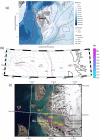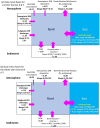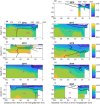Ecosystem metabolism and nitrogen budget of a glacial Fjord in the Arctic
- PMID: 40594564
- PMCID: PMC12215447
- DOI: 10.1038/s41598-025-06953-3
Ecosystem metabolism and nitrogen budget of a glacial Fjord in the Arctic
Abstract
Fjords in the Arctic are changing rapidly due to multiple factors including increasing air temperatures, the influx of Atlantic Water (Atlantification), sea-ice loss, retreat of tidewater glaciers, increased freshwater discharges, pollution and tourism. Understanding how these changes affect ecosystem processes and functions and, thus, services to society is critical. Net Ecosystem Metabolism (NEM) offers a holistic measure of ecosystem functioning and services, reflecting the balance between autotrophic and heterotrophic processes and the sink/source role of an ecosystem for nutrients and carbon. Using a 10-year dataset we quantify the main nutrient sources and sinks in Kongsfjorden (Svalbard) and estimate NEM using a method based on mixing diagrams combined with an ocean circulation model. We show that Kongsfjorden is a nutrient and carbon sink primarily supported by nutrient inputs from the adjacent shelf sea with terrestrial run-off playing a secondary role. Given the ongoing changes in the Arctic, driven by global warming and its associated effects, we recommend monitoring NEM as an integrated measure of the state of coastal ecosystems, considering the disproportionately large role of coastal regions in the global carbon budget.
Keywords: Freshwater endmembers; Glacial fjord; Kongsfjorden; Marine endmembers; Net ecosystem metabolism; Nutrient sink/source.
© 2025. The Author(s).
Conflict of interest statement
Declarations. Competing interests: The authors declare no competing interests.
Figures





References
-
- Gattuso, J. P., Frankignoulle, M. & Wollast, R. Carbon and carbonate metabolism in coastal aquatic ecosystems. Annu. Rev. Ecol. Syst.29, 405–434. 10.1146/annurev.ecolsys.29.1.405 (1998).
-
- Schlegel, R. W. et al. Drivers of change in Arctic fjord socio-ecological systems: Examples from the European Arctic. Cambridge Prisms: Coastal Futures1, e13, 1–18. 10.1017/cft.2023.1 (2023).
-
- Siddons, B. L., Glegg, G. & McQuatters-Gollop, A. Inter-regional coherence: can Northeast Atlantic pelagic habitat indicators be applied to the Arctic?? Mar. Policy. 96, 53–64. 10.1016/j.marpol.2018.07.013 (2018).
LinkOut - more resources
Full Text Sources

